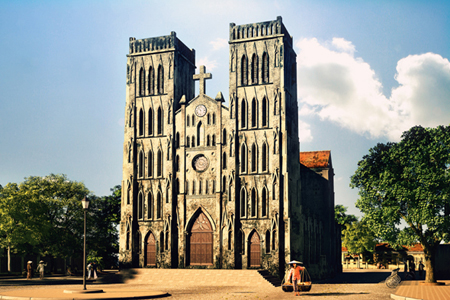This was when the French started their domination over Vietnam. Vietnamese politics also underwent big changes during this period, such as Japan's invasion of Vietnam (1941) and the establishment of the Communist Party of Vietnam (1930), which later took the leading role in the revolution for national independence and led the nation to successes starting with the success of the August Revolution in 1945 and that of the anti- French resistance war in 1954.
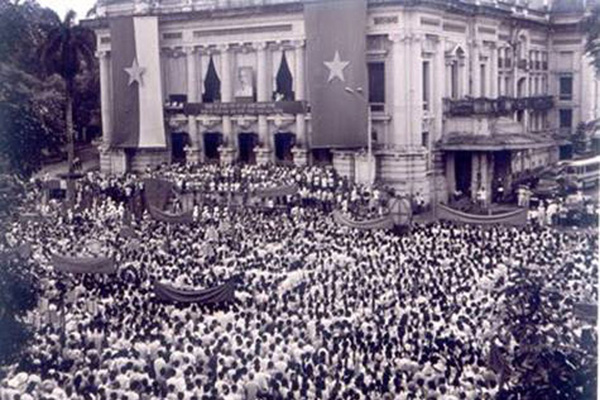
Despite their initial resistance to the French invasion of Vietnam, the Nguyen Dynasty was eventually forced to accept defeat. With the three peace treaties, Nham Tuat Peace Treaty (1862), Giap Tuat Peace Treaty (1874), and Giap Than Peace Treaty or Patenotre Peace Treaty (1884), the Nguyen Dynasty was forced to accept the domination of France and the division of Vietnam into three parts: the South as a colony, the Central as land under protectorate and the North as a semi-colony. Along with these peace treaties, the Nguyen Dynasty was forced to allow Catholics to carry out missionary work freely. Item 2 of Nham Tuat Peace Treaty (1862) stated: "French and Spanish missionaries are permitted to evangelize in Annam. The Annamese are free to become Catholic followers if they wish. No one has the right to impose any religion on the people if they do not want it." Item 10 of the Giap Tuat Peace Treaty (1874) added: "Catholicism teaches people about good things. Therefore, the Vietnamese Emperor shall abolish all prohibiting decrees on Catholicism and give his permission for everyone to freely follow any religion as they wish...The Emperor shall order the destruction of all documents that keep a record of the names of Catholic followers...The Emperor shall also prohibit people from sneering at Catholicism and correct bad words of Catholicism which are found in the Ten Commandments . . . Bishops and priests have the right to rent and purchase land and houses, as well as build churches, hospitals, schools, and other buildings worship; the Emperor has to return all the properties that were unfairly seized from the Catholics."
In return for their help, the French government gave the Society of Foreign Missions of Paris many special privileges. The Society's supremacy was promoted; the priesthood had a long arm in society at that time. Both Vietnamese and foreign priests were, including preachers, paid by the colonial government. The allowance for missionary work increased from 40,000 francs in 1864 to 145,000 francs in 1879. In 1867, the colonial government granted 4,000 francs to the Sai Gon Bishops'Office; in 1872, the amount increased to 170,000 francs. Simultaneously, all missionaries and governors were free from telecommunication costs. Such favorable conditions in both material and spiritual life led to an increase in the number of Catholic believers. The dramatic development of Catholicism in Vietnam during this time can be revealed in the following figures: In 1890, there were 708,000 parishioners, 9 bishops, 575 priests (including 219 foreigners, and 356 Vietnamese), and 930 churches. In 1910, the number of parishioners rose to 900,000. In 1939, there were 1,544,765 parishioners, 1,662 priests (including 1,343 Vietnamese) and 979 parishes. Specifically, there were 1,151,653 parishioners, 1,132 priests (including 932 Vietnamese), and 633 parishes in the North; 170,573 parishioners, 264 priests (including 203 Vietnamese), and 178 parishes in the Central; and 222,539 parishioners, 266 priests (including 208 Vietnamese) and 168 parishes in the South.
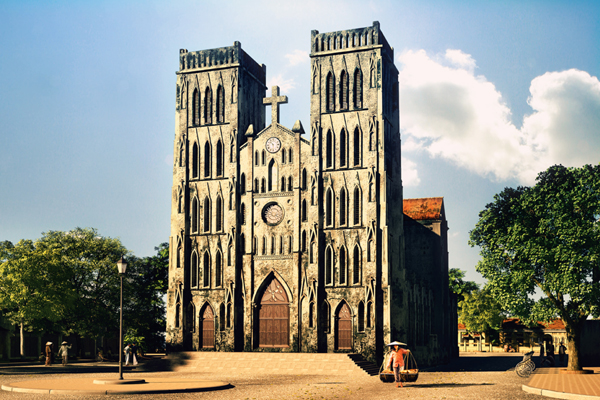
During this time, the colonial government also offered grants for the building of churches and monasteries. Thousands of religious buildings were built, many of which were as large- scale as the Phat Diem Stone Church in Ninh Binh built-in 1891 by priest Tran Dinh Luc (or Sau in Vietnamese). Typical ones included the Hanoi Cathedral, also known as the Saint Joseph Cathedral, whose construction was started in 1882 and was completed in 1886 in the period of Bishop Puginier; the Phu Cam Church, Hue, whose construction was begun in 1885 and finished in 1902; and the Sai Gon Notre-Dame Basilica, whose construction was started in 1863 and completed in 1880 and cost as much as 2.5 million francs. In 1861, Bishop Lefebvre established the Adran Seminary in Sai Gon (present-day Ho Chi Minh City). After that, many other seminaries were built such as the Saint Joseph Seminary in My Tho in 1867, the Taberd Seminary in Sai Gon in 1874, the Puginier Seminary in Hanoi in 1884, the Pellerin Seminary in Hue in 1904, and another Saint Joseph Seminary in Hai Phong in 1906.’
With such privileges, the Catholic Church took possession of a lot of lands. According to the report of Bishop Colombert, in 1887, the Southwest Diocese owned 1,000 hectares equivalent to 50,000 francs. Unsurprisingly, the Catholic Church was likened to a "landowner." In the face of this situation, in 1887, the colonial government attempted to limit the land purchases of the Catholic Church by stating that the value of their land should not exceed 10,000 francs.
Although Catholicism caused conflicts within the Vietnamese society in terms of rites, ideological values, and politics, it also had some certain positive effects on the then society and culture of Vietnam. Catholic missionaries introduced many European scientific and technological advances into Vietnam in such fields as astronomy, medicine, and geography. In the period of the Nguyen and Trinh Lords, these missionaries brought many novels presents to Vietnam that surprised the kings, lords, and mandarins such as spring-driven clocks, sand clocks, and compasses. They also introduced new developments in medicine and surgery. This inspired the Trinh Lords to begin building hospitals in as early as 1627 such as Phu Doan Hospital (present-day Viet Duc Hospital) and Saint Paul Hospital in Hanoi and Cho Quan Hospital in Sai Gon. The missionaries also popularized new techniques in weaving with the use of large frames resulting in smooth cloth surface and those in printing with the use of leaden and bronze letters on paper leading to a revolution in printing in Vietnam. In the early nineteenth century, almost every diocese had a printing house for the publication of prayer-books. Some of these printing houses included the Vinh Tri Printing House (Ha Nam), Ke Nhau Printing House (Ha Tay), Nha Chung Printing House, and Tan Dinh Printing House (South Vietnam). Along with popularizing the Latin- base writing system among the people, the missionaries also carried out missionary work via newspapers. By the early twentieth century, 20 out of 40 newspapers in Vietnam were published by Catholic missionaries. The earliest newspaper, Gia Dinh Bao (Gia Dinh Newspaper), was first printed in 1865 and written mainly by Catholic intellectuals like Truong Vinh Ky, Huynh Tinh Cua, and Truong Minh Ky. The early twentieth century witnessed the birth of a series of Catholic newspapers such as Trung Hoa nhat bao (Trung Hoa Daily), Duc Me hang cuu giup (Our Mother of Perpetual Help) in Hanoi, Van Coi in Nam Dinh, Da Minh (Dominican) in Bui Chu, Sacerdos in Vinh, Cong giao Nam Thanh (Nam Thanh Catholicism) later changed to Thanh nien (Youth), Vi Chua (For God) in Cua Tung and Nam Ky Dia phan (Southern Diocese) in Sai Gon, which had the longest existence - from 1908 to 1945.
Due to the increase in the number of Catholic believers, Pope Leo XIII divided the West Dang Ngoai Diocese into West Diocese (Hanoi) and Doai Diocese (Hung Hoa) in 1895. In 1901, Pope Leo XIII further divided the West Diocese into West Diocese and Thanh Diocese (Phat Diem, present-day Ninh Binh province). Later, Pope Pius X divided the North Dang Ngoai into North Diocese (Bac Ninh) and the Lang Son Apostolic Prefecture in 1913. Finally, in 1932, Pope Pius XI further divided the Thanh Diocese into Phat Diem and Thanh Hoa and the East Dang Trong into Qui Nhon and Kon Turn.
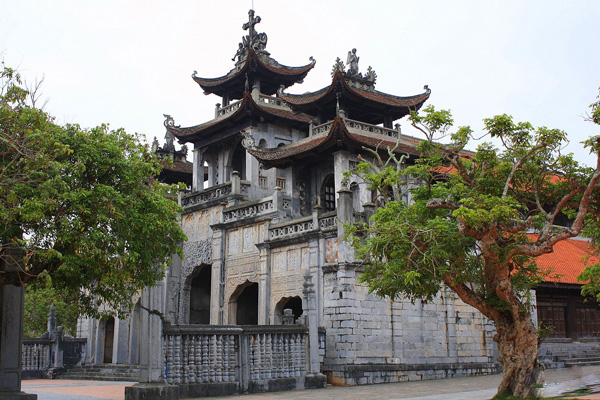
By 1913, there were totally eleven dioceses and one apostolic prefecture in Vietnam. By 1932, the number of dioceses increased to thirteen. In order to support the Catholic Church in Indochina in general and in Vietnam in particular, the Vatican built the Palace of the French Resident Superior in Phu Cam, Hue. The first French Resident Superior in Vietnam was c. Dreyer (from 1928 to 1936). His successors are as follows: A. Drapier (from 1936 to 1950) and J. Dooley (from 1950 to 1959) at the Hanoi Archbishop's Palace; J. Caprio (from 1956 to 1957), M. Brini (from 1959 to 1962), s. Aster (1962), A. Polmas (from 1962 to 1969), and H. Lemaitre (1969-1976) at the Sai Gon Archbishop's Palace. In 1951, during the time of J. Dooley, the Palace of the French Resident Superior was moved from Hue to Hanoi.
This period also witnessed the mushroom growth of orders in Vietnam, either imported from other countries or established domestically. These orders are presented below chronologically.
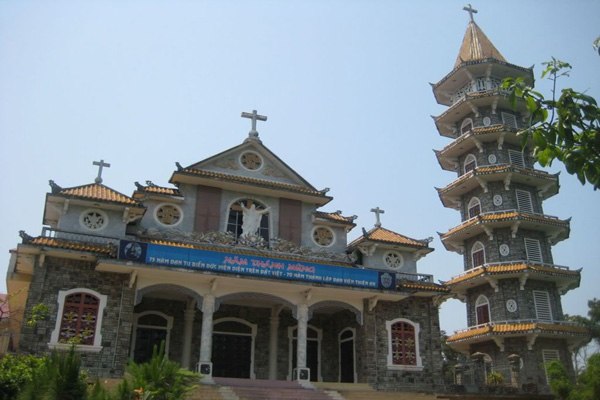
Male orders are as follows:
- The Order of Preachers (also known as the Dominican Order or Dominicans) was first introduced into Vietnam in 1550 and gained influence in such dioceses as Bui Chu, Thai Binh, Hai Phong, and Bac Ninh. Since 1930, with the further evangelization of the priests from Dominico de Leon (France), its influence was expanded to Lang Son.
- The Institute of the Brothers of Christian Schools, which was originally founded in France by Baptiste de la Salle, was introduced into Vietnam in 1886 by French priests. This order opened many schools that were named after the French bishops during the period of missionary work such as the Tabert School in Sai Gon, the Pellerin School in Hue, and the Pujinier School in Hanoi.
- The Order of Vietnam Cistercians was founded by Priest Henri Denis in 1918 in Hue and was later widened to Ninh Binh in 1936 and Dong Nai in 1950.
- The Order of Saint Benedict was founded in Da Lat in 1936 by Priest Maur Masse and was later expanded to Hue in 1940.
- The Order of the Most Holy Redeemer was first introduced into Vietnam in 1925 mainly by Canadian priests.
- The Order of Friars Minor entered Vietnam in 1929 with the first establishment in Nghe An.
- The Order of Saint Giuse was founded by Priest jean Sion in Qui Nhon in 1931.
- The Salesians of Saint John Bosco entered Vietnam in the early 1940s with its first establishments in Saigon and was then expanded to other places such as Da Lat.
- The Order of Saint John of God was introduced into Vietnam during 1938-1939 by a group of Canadian priests. Its first establishments were found in Nam Dinh and Hanoi.
- The Congregation of the Mother Co-Redemptrix was founded in Nam Dinh in 1953.
- The Order of the Little Brothers of Jesus came to Vietnam in 1954.
Female orders are as follows:
- The Congregation of the Lovers of the Holy Cross was founded by Lambert de la Motte in Dang Ngoai in 1670 and in Dang Trong in 1671. Its other establishments were then found in Hue (1719), Cai Nhum (1800), Thu Thiem (1840), Cai Mon (1844), Vinh (1846), Cho Quan (1852), Qui Nhon (1932), and Da Lat (1932).
- The Order of Discalced Carmelites was first introduced in Vietnam in 1861 with its first establishment in Sai Gon. Then it was spread to Hanoi in 1895, Hue in 1909, Nam Dinh in 1923, and Thanh Hoa in 1929.
- The Order of Saint Paul was first introduced into Vietnam in 1860 with its first establishment in Sai Gon. Then it was expanded to Hue(1889), Hanoi (1883), Nam Dinh, Hai Phong, and others.
The Order of the Sisters of Providence entered Vietnam in 1876 with its first establishment in the Southwest. - The Order of Notre Dame Mission came to Vietnam in 1924 with its first establishments founded in Phat Diem and Thanh Hoa in 1926. In 1941, it was expanded to Hanoi.
- The Order of Saint Francisco was founded in Vietnam by French nuns in 1930 with its first establishment in Qui Nhon. Its foundations for charity and education were later established in Sai Gon and Da Lat.
- The Congregation of Notre Dame had its first foundation established in Hanoi in 1934. Later, it was expanded to the South with many other foundations established in Sai Gon, Da Lat, Nha Trang, and Phan Thiet.
- The Order of Saint Benedict came to Vietnam in 1935 with its first establishment in Ban Me Thuot. Later it was spread to Sai Gon.
- The Congregation of Charity of Saint Vincent de Paul was founded by a French nun in 1935 in Da Lat. Then it was spread to Sai Gon and other provinces like Nha Trang and Ban Me Thuot.
- Filles de la Medaille Miraculeuse was founded in 1947 in Kon Turn.
Such orders played a key role in promoting the evangelization and maintenance of the Catholic Church in Vietnam.

